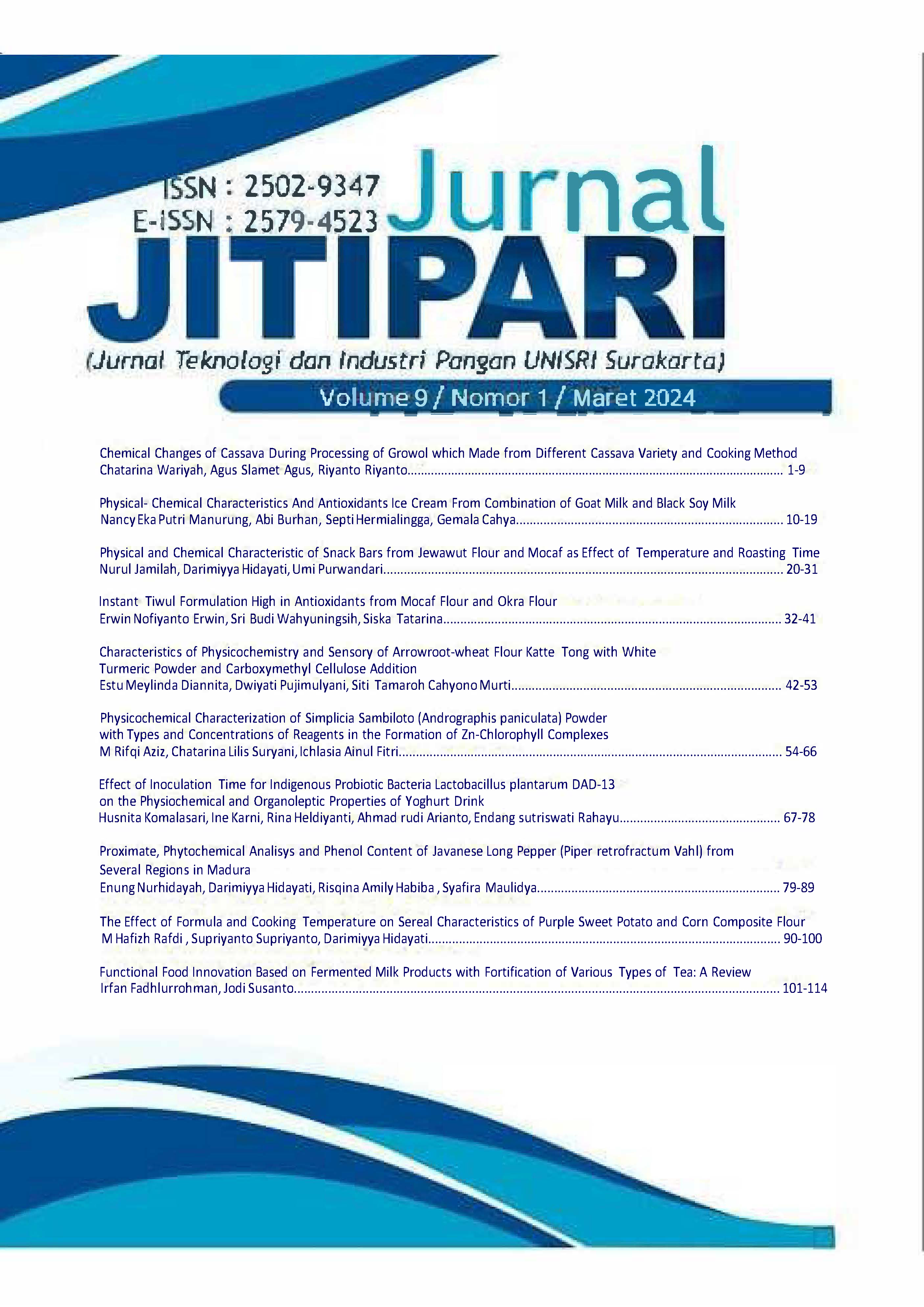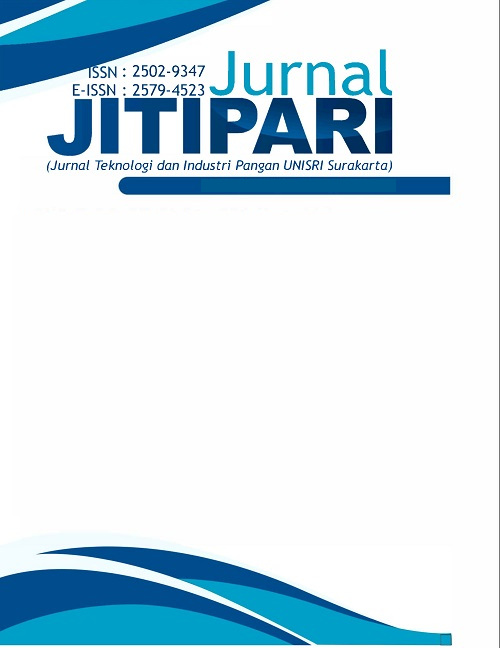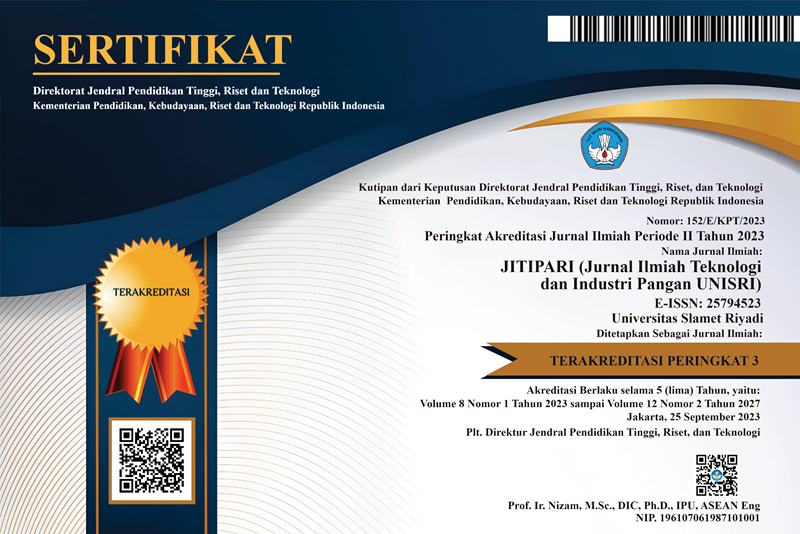Functional Food Innovation Based on Fermented Milk Products with Fortification of Various Types of Tea: A Review
Inovasi Pangan Fungsional Berbasis Produk Susu Fermentasi dengan Fortifikasi Berbagai Jenis Teh: Review
DOI:
https://doi.org/10.33061/jitipari.v9i1.10221Abstract
Today's people tend to consume healthy food, for example, functional food. Functional foods from fermented milk products which contain many bioactive compounds include yogurt, kefir, and cheese. The nutritional value of this product can be further increased through fortification of various types of tea. This research aims to summarize results related to the fortification of various types of tea in yogurt, kefir, and cheese products as a functional food innovation based on fermented milk. Based on various research, tea fortification in fermented milk products can increase the functional value of the product. Fortification of green tea, oolong tea, white tea, and black tea as much as 0.5 – 4% has been proven to increase the total phenolic content, antioxidant activity, antimicrobial and LAB growth as well as produce better color, texture, and sensory properties of yogurt. Green tea and black tea fortification of 1 – 4% is also believed to produce kefir with better antimicrobial and antioxidant activity and has a lower calorific value than products without tea fortification. Cheese with green tea or orthodox black tea fortification of 0.1 – 2% or 2 g/kg has been proven to be able to enrich polyphenolic compounds up to 2 times, and the antiradical activity of the cheese is up to 44%, and the antioxidant activity of the cheese is 14% higher than the control. Based on the research that has been carried out, it is believed that the fortification of various types of tea in yogurt, kefir, and cheese products can be an innovation in the development of functional food which can have a better impact on body health.
References
Akdeniz, V., & Akalın, A. S. (2019). New approach for yoghurt and ice cream production: High-intensity ultrasound. Trends in Food Science and Technology, 86, 392–398. https://doi.org/10.1016/j.tifs.2019.02.046
Al-hamdani, H. M. S., Ahmed, S. H., & SalwaKhudadat. (2021). Developing soft cheese industry supported with medicinal herbs as functional food. Iraqi Journal of Market Research and Consumer Protection, 13(1), 1–13. https://jmracpc.uobaghdad.edu.iq/index.php/IJMRCP/article/view/224
Anjarsari, D., & Ratna, I. (2016). Katekin teh Indonesia: prospek dan manfaatnya. Kultivasi, 15(2), 99–106. https://doi.org/10.24198/kultivasi.v15i2.11871
Badan Pusat Statistik. (2022). Statistik Teh Indonesia 2021. BPS-Statistics Indonesia.
Badan Standardisasi Nasional. (2016). SNI 1902:2016 Syarat Mutu Teh Hitam. Badan Standardisasi Nasional, Jakarta.
Badan Standardisasi Nasional. (2018). SNI 2980:2018 Keju Olahan. Badan Standardisasi Nasional, Jakarta.
Beltrán-Barrientos, L. M., Hernández-Mendoza, A., Torres-Llane, M. J., González-Córdova, A. F., & Vallejo-Córdoba, B. (2016). Invited review: Fermented milk as antihypertensive functional food. Journal of Dairy Science, 99(6), 4099–4110. https://doi.org/10.3168/jds.2015-10054
Casado-coterillo, C., DÃaz-guridi, P., Otero, J. A., & Ibáñez, R. (2023). Modeling of lactic acid rejection from lactose in acidified cheese whey by nanofiltration. Journal of Dairy Science, 106(7), 1–12. https://doi.org/10.3168/jds.2022-22502
Celik, O. F., & Kilicaslan, M. (2023). Improving the antioxidant activity of yogurt through black and green tea supplementation. International Journal of Food Science and Technology, 58(5), 6121–6130. https://doi.org/10.1111/ijfs.16722
Chen, C., Wu, S., Li, Y., Huang, Y., & Yang, X. (2022). Effects of Different Acetic Acid Bacteria Strains on the Bioactive Compounds, Volatile Compounds and Antioxidant Activity of Black Tea Vinegar. LWT - Food Science and Technology, 171, 114131. https://doi.org/10.1016/j.lwt.2022.114131
Chen, Q., Shi, J., Mu, B., Chen, Z., Dai, W., & Lin, Z. (2020). Metabolomics combined with proteomics provides a novel interpretation of the changes in nonvolatile compounds during white tea processing. Food Chemistry, 332, 127412. https://doi.org/10.1016/j.foodchem.2020.127412
Chen, Y. L., Duan, J., Jiang, Y. M., Shi, J., Peng, L., Xue, S., & Kakuda, Y. (2011). Production, quality, and biological effects of oolong tea (Camellia sinensis). Food Reviews International, 27(1), 1–15. https://doi.org/10.1080/87559129.2010.518294
Fadhilah, Z. H., Perdana, F., Aldizal, R., & Rizkio, M. (2021). Review: Telaah kandungan senyawa katekin dan epigalokatekin galat (EGCG) sebagai antioksidan pada berbagai jenis teh. Jurnal Pharmascience, 8(1), 31–44.
Fadhlurrohman, I. (2022). Pengembangan Keju sebagai Pangan Fungsional dengan Penambahan Teh Hitam Orthodox. Tesis Magister, Universitas Jenderal Soedirman.
Fadhlurrohman, I., Setyawardani, T., & Sumarmono, J. (2023a). Development of Cheese as an Antioxidant Functional Food with the Addition of Orthodox Black Tea. Tropical Animal Science Journal, 46(3), 367–374. https://doi.org/10.5398/tasj.2023.46.3.367
Fadhlurrohman, I., Setyawardani, T., & Sumarmono, J. (2023b). Karakteristik Warna (Hue, Chroma, Whiteness Index), Rendemen, dan Persentase Whey Keju dengan Penambahan Teh Hitam Orthodox (Camellia sinensis var. assamica). JITIPARI (Jurnal Ilmiah Teknologi Dan Industri Pangan UNISRI), 8(1), 10–19. https://doi.org/10.33061/jitipari.v8i1.8133
Giroux, H. J., Grandpré, G. De, Fustier, P., Champagne, C. P., St-gelais, D., Lacroix, M., & Britten, M. (2013). Production and characterization of cheddar-type cheese enriched with green tea extract. Dairy Science & Technology, 93, 241–254. https://doi.org/10.1007/s13594-013-0119-4
Granato, D., Carocho, M., Barros, L., Zabetakis, I., Mocan, A., Tsoupras, A., Cruz, A. G., & Pimentel, T. C. (2022). Implementation of Sustainable Development Goals in the dairy sector: Perspectives on the use of agro-industrial side-streams to design functional foods. Trends in Food Science and Technology, 124, 128–139. https://doi.org/10.1016/j.tifs.2022.04.009
Habiburrohman, D., & Sukohar, A. (2018). Aktivitas antioksidan dan antimikrobial pada polifenol teh hijau. Jurnal Agromedicine Unila, 5(2), 587–591.
Hilal, Y., & Engelhardt, U. (2009). Characterisation of white tea— Comparison to green and black tea. Journal Für Verbraucherschutz Und Lebensmittelsicherheit, 2(4), 414–421. https://doi.org/10.1007/s00003-009-0485-2
Hirose, S., Tomatsu, K., & Yanase, E. (2013). Isolation of key intermediates during formation of oolongtheanins. Tetrahedron Letters, 54(51), 7040–7043. https://doi.org/10.1016/j.tetlet.2013.10.069
Hosseini, F., Motamedzadegan, A., Raeisi, S. N., & Rahaiee, S. (2023). Antioxidant activity of nanoencapsulated chia (Salvia hispanica L.) seed extract and its application to manufacture a functional cheese. Food Science and Nutrition, 11(3), 1328–1341. https://doi.org/10.1002/fsn3.3169
International Tea Committee. (2019). Annual bulletin statistic 2019. UK.
Jeong, C. H., Ryu, H., Zhang, T., Lee, C. H., Seo, H. G., & Han, S. G. (2018). Green tea powder supplementation enhances fermentation and antioxidant activity of set-type yogurt. Food Science and Biotechnology, 27(5), 1419–1427. https://doi.org/10.1007/s10068-018-0370-9
Karagozlu, C., Unal, G., Akalin, A. S., Akan, E., & Kinik, O. (2017). The effects of black and green tea on antioxidant activity and sensory characteristics of kefir. Agro Food Industry Hi-Tech, 28(2), 77–80.
Karagözlü, C., Ünal, G., Akalın, A. S., Akan, E., & Kınık, Ö. (2018). The supplementary effect of black and green tea infusion on antimicrobial activities of kefir. Food and Health, 4(2), 124–131. https://doi.org/10.3153/fh18012
Kirmaz, C., Kinik, Ö., & İçier, F. (2023). Determination of rheological properties of kefir produced with buffalo milk and other milk mixtures. Journal of Agriculture Faculty of Ege University, 60(1), 37–51. https://doi.org/10.20289/zfdergi.1120746
Klojdová, I., & Stathopoulos, C. (2022). W/o/w multiple emulsions: A novel trend in functional ice cream preparations? Food Chemistry: X, 16, 100451. https://doi.org/10.1016/j.fochx.2022.100451
Kusumastuti, M. R., Susanti, S., & Legowo, A. M. (2023). Karakteristik es krim kefir green tea sebagai pangan fungsional antiobesitas. Jurnal Penelitian Pangan (Indonesian Journal of Food Research), 3(1), 1–8. https://doi.org/10.24198/jp2.2023.vol1.1.01
Lamothe, S., Langlois, A., Bazinet, L., Couillard, C., & Britten, M. (2016). Antioxidant activity and nutrient release from polyphenol-enriched cheese in a simulated gastrointestinal environment. Food and Function, 7(3), 1634–1644. https://doi.org/10.1039/c5fo01287b
Li, A., Ma, Y., Cui, N., Zhang, X., Zheng, Q., Du, P., & Sun, M. (2023). Research progress of milk and dairy products to prevent caries. Journal of Functional Foods, 110, 105837. https://doi.org/10.1016/j.jff.2023.105837
Lin, S. Y., Lo, L. C., Chen, I. Z., & Chen, P. A. (2016). Effect of shaking process on correlations between catechins and volatiles in oolong tea. Journal of Food and Drug Analysis, 24(3), 500–507. https://doi.org/10.1016/j.jfda.2016.01.011
Liu, Z., Vincken, J. P., & de Bruijn, W. J. C. (2022). Tea Phenolics as Prebiotics. Trends in Food Science and Technology, 127, 156–168. https://doi.org/10.1016/j.tifs.2022.06.007
McSweeney, P. L. H. (2007). Cheese problems solved. Elsevier.
Muniandy, P., Shori, A. B., & Baba, A. S. (2015). Comparison of the effect of green, white and black tea on Streptococcus thermophilus and Lactobacillus spp. in yogurt during refrigerated storage. Journal of the Association of Arab Universities for Basic and Applied Sciences, 22, 26–30. https://doi.org/10.1016/j.jaubas.2015.11.002
Muniandy, P., Shori, A. B., & Baba, A. S. (2016). Influence of green, white and black tea addition on the antioxidant activity of probiotic yogurt during refrigerated storage. Food Packaging and Shelf Life, 8, 1–8. https://doi.org/10.1016/j.fpsl.2016.02.002
Pamela, V. Y., Riyanto, R. A., Kusumasari, S., Meindrawan, B., Diwan, A. M., & Istihamsyah, I. (2022). Karakteristik karakteristik sifat organoleptik yoghurt dengan variasi susu skim dan lama inkubasi. Nutriology: Jurnal Pangan, Gizi, Kesehatan, 3(1), 18–24. https://doi.org/10.30812/nutriology.v3i1.1963
Paramita, N. L. P. V., Andari, N. P. T. W., Andani, N. M. D., & Susanti, N. M. P. (2020). Penetapan kadar fenol total dan katekin daun teh hitam dan ekstrak aseton teh hitam dari tanaman Camellia sinensis Var. assamica. Jurnal Kimia, 14(1), 43. https://doi.org/10.24843/jchem.2020.v14.i01.p08
Prawira-Atmaja, M. I., & Rohdiana, D. (2018). Diversifikasi produk berbasis teh pada industri pangan, farmasi, dan komestik. Perspektif, 17(2), 150–165.
Raras, T. Y. M. (2022). Tinjauan literatur: Kefir: mikrobiologi, senyawa bioaktif, dan manfaatnya pada penyakit noninfeksi. Majalah Kesehatan, 9(4), 263–280. https://doi.org/10.21776/majalahkesehatan.2022.009.04.7
Rashidinejad, A., Birch, E. J., & Everett, D. W. (2016a). A novel functional full-fat hard cheese containing liposomal nanoencapsulated green tea catechins: manufacture and recovery following simulated digestion. Food and Function, 7(7), 3283–3294. https://doi.org/10.1039/c6fo00354k
Rashidinejad, A., Birch, E. J., & Everett, D. W. (2016b). Antioxidant activity and recovery of green tea catechins in full-fat cheese following gastrointestinal simulated digestion. Journal of Food Composition and Analysis, 48, 13–24. https://doi.org/10.1016/j.jfca.2016.02.004
Rashidinejad, A., Birch, E. J., Hindmarsh, J., & Everett, D. W. (2017). Molecular interactions between green tea catechins and cheese fat studied by solid-state nuclear magnetic resonance spectroscopy. Food Chemistry, 215, 228–234. https://doi.org/10.1016/j.foodchem.2016.07.179
Rashidinejad, A., Birch, E. J., Sun-waterhouse, D., & Everett, D. W. (2014). Delivery of green tea catechin and epigallocatechin gallate in liposomes incorporated into low-fat hard cheese. Food Chemistry, 156, 176–183. https://doi.org/10.1016/j.foodchem.2014.01.115
Rashidinejad, A., Birch, E. J., Sun-waterhouse, D., & Everett, D. W. (2016). Effect of liposomal encapsulation on the recovery and antioxidant properties of green tea catechins incorporated into a hard low-fat cheese following in vitro simulated gastrointestinal digestion. Food and Bioproducts Processing, 100, 238–245. https://doi.org/10.1016/j.fbp.2016.07.005
Reque, P. M., & Brandelli, A. (2021). Encapsulation of probiotics and nutraceuticals: Applications in functional food industry. Trends in Food Science and Technology, 114, 1–10. https://doi.org/10.1016/j.tifs.2021.05.022
Robalo, J., Lopes, M., Cardoso, O., Silva, A. S., & Ramos, F. (2022). Efficacy of whey protein film incorporated with portuguese green tea (Camellia sinensis L.) extract for the preservation of latin-style fresh cheese. Foods, 11(8), 1158. https://doi.org/10.3390/foods11081158
Rohdiana, D. (2015). Teh: Proses, Karakteristik dan Komponen Fungsionalnya. Food Review Indonesia, 10(8), 34–37.
Setyawardani, T., Rahardjo, A. H. D., & Sulistyowati, M. (2017). Chemical Characteristics of Goat Cheese with Different Percentages of Mixed Indigenous Probiotic Culture during Ripening. Media Peternakan, 40(1), 55–62. https://doi.org/10.5398/medpet.2017.40.1.55
Setyawardani, T, Sumarmono, J., Rahardjo, A. H. D., Arkan, N. D., & Fadhlurrohman, I. (2024). Quality of yogurt produced from various types of milk as raw materials. IOP Conference Series: Earth and Environmental Science, 1292, 012020. https://doi.org/10.1088/1755-1315/1292/1/012020
Setyawardani, Triana, Sumarmono, J., Djoko Rahardjo, A. H., Sulistyowati, M., & Widayaka, K. (2017). Kualitas kimia, fisik dan sensori kefir susu kambing yang disimpan pada suhu dan lama penyimpanan berbeda. Buletin Peternakan, 41(3), 298. https://doi.org/10.21059/buletinpeternak.v41i3.18266
Setyawardani, Triana, Sumarmono, J., Hantoro, A., Rahardjo, D., Arkan, N. D., & Fadhlurrohman, I. (2023). Kualitas Kefir yang Diproduksi dengan Berbagai Jenis Bahan Baku Susu. Prosiding Seminar Teknologi Dan Agribisnis Peternakan X, 59–64.
Sumarmono, J. (2016). Yogurt dan Concentrated Yogurt Makanan Fungsional dari Susu. Lembaga Penelitian dan Pengabdian Kepada Masyarakat Universitas Jenderal Soedirman, Purwokerto.
Sumarmono, J., & Suhartati, F. M. (2012). Yield dan komposisi keju lunak (soft cheese) dari susu sapi yang dibuat dengan teknik direct acidification menggunakan buah lokal. Jurnal Aplikasi Teknologi Pangan, 1(3), 65–68.
Swiader, K., Florowska, A., Konisiewicz, Z., & Chen, Y. (2020). Functional tea-infused set yoghurt development by evaluation of sensory quality and textural properties. Foods, 9, 1–19.
Tan, J., Engelhardt, U. H., Lin, Z., Kaiser, N., & Maiwald, B. (2017). Flavonoids, phenolic acids, alkaloids and theanine in different types of authentic Chinese white tea samples. Journal of Food Composition and Analysis, 57, 8–15. https://doi.org/10.1016/j.jfca.2016.12.011
Tanaka, T., Watarumi, S., Matsuo, Y., Kamei, M., & Kouno, I. (2003). Production of theasinensins A and D, epigallocatechin gallate dimers of black tea, by oxidation-reduction dismutation of dehydrotheasinensin A. Tetrahedron, 59(40), 7939–7947. https://doi.org/10.1016/j.tet.2003.08.025
Tomar, O., Akarca, G., Çağlar, A., Beykaya, M., & Gök, V. (2020). The effects of kefir grain and starter culture on kefir produced from cow and buffalo milk during storage periods. Food Science and Technology, 2061(1), 238–244.
Triwibowo, B., Wicaksono, R., Antika, Y., Ermi, S., Jarmiati, A., Ari Setiadi, A., & Syahriar, R. (2020). The effect of kefir grain concentration and fermentation duration on characteristics of cow milk-based kefir. Journal of Physics: Conference Series, 1444(1). https://doi.org/10.1088/1742-6596/1444/1/012001
Ünal, G., Karagozlu, C., Kinik, Ö., Akan, E., & Akalin, A. S. (2018). Effect of supplementation with green and black tea on microbiological characteristics, antimicrobial and antioxidant activities of drinking yoghurt. Journal of Agricultural Science, 24(2), 153–161. https://doi.org/10.15832/ankutbd.446430
Wang, Y., Kan, Z., Thompson, H. J., Ling, T., Ho, C. T., Li, D., & Wan, X. (2019). Impact of Six Typical Processing Methods on the Chemical Composition of Tea Leaves Using a Single Camellia sinensis Cultivar, Longjing 43. Journal of Agricultural and Food Chemistry, 67(19), 5423–5436. https://doi.org/10.1021/acs.jafc.8b05140
Wibowo, N. K., Rudyanto, M., & Agus Purwanto, D. (2022). Aktivitas antioksidan teh hijau dan teh hitam. Camellia: Clinical, Pharmaceutical, Analytical and Pharmacy Community Journal, 1(2), 48–55.
Wong, M., Sirisena, S., & Ng, K. (2022). Phytochemical Profile of Differently Processed Tea: A Review. Journal of Food Science, 87(5), 1925–1942. https://doi.org/10.1111/1750-3841.16137
Xu, Y. Q., Liu, P. P., Shi, J., Gao, Y., Wang, Q. S., & Yin, J. F. (2018). Quality development and main chemical components of Tieguanyin oolong teas processed from different parts of fresh shoots. Food Chemistry, 249, 176–183. https://doi.org/10.1016/j.foodchem.2018.01.019
Zhu, F., Sakulnak, R., & Wang, S. (2016). Effect of Black Tea on Antioxidant, Textural, and Sensory Properties of Chinese Steamed Bread. Food Chemistry, 194, 1217–1223. https://doi.org/10.1016/j.foodchem.2015.08.110
Downloads
Published
How to Cite
Issue
Section
License
Copyright (c) 2024 Irfan Fadhlurrohman, Jodi Susanto

This work is licensed under a Creative Commons Attribution-ShareAlike 4.0 International License.
Authors who publish this journal agree to the following terms:
- Authors retain copyright and grant the journal right of first publication with the work simultaneously licensed under a Creative Commons Attribution-ShareAlike 4.0 International (CC BY-SA 4.0) that allows others to share the work with an acknowledgement of the work's authorship and initial publication in this journal.
- Authors can separately make additional contractual arrangements for non-exclusive distribution published by the journal (e.g., publish it in a book), with an acknowledgement of its initial publication in this journal.
- Authors are allowed and encouraged to send their work via online (e.g., in the institutional repositories or their website) after published by the journal.










